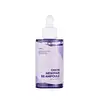What's inside
What's inside
 Key Ingredients
Key Ingredients

 Benefits
Benefits

 Concerns
Concerns

No concerns
 Ingredients Side-by-side
Ingredients Side-by-side

Water
Skin ConditioningGlycerin
HumectantNiacinamide
SmoothingAlcohol Denat.
AntimicrobialDimethicone
EmollientIsononyl Isononanoate
EmollientCeramide NP
Skin ConditioningCarbomer
Emulsion StabilisingDimethiconol
EmollientParfum
MaskingSodium Hydroxide
BufferingSalicylic Acid
MaskingSodium Hyaluronate
HumectantPhenoxyethanol
PreservativePrunus Lannesiana Flower Extract
Skin ConditioningTocopheryl Acetate
AntioxidantLimonene
PerfumingCaprylyl Glycol
EmollientCapryloyl Salicylic Acid
ExfoliatingTetrasodium Glutamate Diacetate
Citronellol
PerfumingBiosaccharide Gum-1
HumectantXanthan Gum
EmulsifyingMenthoxypropanediol
MaskingPseudoalteromonas Ferment Extract
HumectantButylene Glycol
HumectantHexyl Cinnamal
PerfumingWater, Glycerin, Niacinamide, Alcohol Denat., Dimethicone, Isononyl Isononanoate, Ceramide NP, Carbomer, Dimethiconol, Parfum, Sodium Hydroxide, Salicylic Acid, Sodium Hyaluronate, Phenoxyethanol, Prunus Lannesiana Flower Extract, Tocopheryl Acetate, Limonene, Caprylyl Glycol, Capryloyl Salicylic Acid, Tetrasodium Glutamate Diacetate, Citronellol, Biosaccharide Gum-1, Xanthan Gum, Menthoxypropanediol, Pseudoalteromonas Ferment Extract, Butylene Glycol, Hexyl Cinnamal
Allium Cepa Bulb Extract 85%
Skin ConditioningPanthenol 5%
Skin Conditioning1,2-Hexanediol
Skin ConditioningNiacinamide
SmoothingTrehalose
HumectantBetaine
HumectantAcrylates/C10-30 Alkyl Acrylate Crosspolymer
Emulsion StabilisingArginine
MaskingButylene Glycol
HumectantCaprylyl Glycol
EmollientWater
Skin ConditioningAllantoin
Skin ConditioningPentylene Glycol
Skin ConditioningHydroxyacetophenone
AntioxidantCaffeine
Skin ConditioningAcetyl Glucosamine
Skin ConditioningMelia Azadirachta Flower Extract
Skin ConditioningAdenosine
Skin ConditioningAmmonium Acryloyldimethyltaurate/Vp Copolymer
Coccinia Indica Fruit Extract
Skin ConditioningDisodium EDTA
Tranexamic Acid
AstringentSodium Hyaluronate
HumectantHydrolyzed Hyaluronic Acid
HumectantSodium Acetylated Hyaluronate
HumectantFerulic Acid
AntimicrobialAllium Cepa Bulb Extract 85%, Panthenol 5%, 1,2-Hexanediol, Niacinamide, Trehalose, Betaine, Acrylates/C10-30 Alkyl Acrylate Crosspolymer, Arginine, Butylene Glycol, Caprylyl Glycol, Water, Allantoin, Pentylene Glycol, Hydroxyacetophenone, Caffeine, Acetyl Glucosamine, Melia Azadirachta Flower Extract, Adenosine, Ammonium Acryloyldimethyltaurate/Vp Copolymer, Coccinia Indica Fruit Extract, Disodium EDTA, Tranexamic Acid, Sodium Hyaluronate, Hydrolyzed Hyaluronic Acid, Sodium Acetylated Hyaluronate, Ferulic Acid
 Reviews
Reviews

Ingredients Explained
These ingredients are found in both products.
Ingredients higher up in an ingredient list are typically present in a larger amount.
Butylene Glycol (or BG) is used within cosmetic products for a few different reasons:
Overall, Butylene Glycol is a safe and well-rounded ingredient that works well with other ingredients.
Though this ingredient works well with most skin types, some people with sensitive skin may experience a reaction such as allergic rashes, closed comedones, or itchiness.
Learn more about Butylene GlycolCaprylyl Glycol is a humectant and emollient, meaning it attracts and preserves moisture.
It is a common ingredient in many products, especially those designed to hydrate skin. The primary benefits are retaining moisture, skin softening, and promoting a healthy skin barrier.
Though Caprylyl Glycol is an alcohol derived from fatty acids, it is not the kind that can dry out skin.
This ingredient is also used as a preservative to extend the life of products. It has slight antimicrobial properties.
Learn more about Caprylyl GlycolNiacinamide is a multitasking form of vitamin B3 that strengthens the skin barrier, reduces pores and dark spots, regulates oil, and improves signs of aging.
And the best part? It's gentle and well-tolerated by most skin types, including sensitive and reactive skin.
You might have heard of "niacin flush", or the reddening of skin that causes itchiness. Niacinamide has not been found to cause this.
In very rare cases, some individuals may not be able to tolerate niacinamide at all or experience an allergic reaction to it.
If you are experiencing flaking, irritation, and dryness with this ingredient, be sure to double check all your products as this ingredient can be found in all categories of skincare.
When incorporating niacinamide into your routine, look out for concentration amounts. Typically, 5% niacinamide provides benefits such as fading dark spots. However, if you have sensitive skin, it is better to begin with a smaller concentration.
When you apply niacinamide to your skin, your body converts it into nicotinamide adenine dinucleotide (NAD). NAD is an essential coenzyme that is already found in your cells as "fuel" and powers countless biological processes.
In your skin, NAD helps repair cell damage, produce new healthy cells, support collagen production, strengthen the skin barrier, and fight environmental stressors (like UV and pollution).
Our natural NAD levels start to decline with age, leading to slower skin repair, visible aging, and a weaker skin barrier. By providing your skin niacinamide, you're recharging your skin's NAD levels. This leads to stronger, healthier, and younger looking skin.
Another name for vitamin B3 is nicotinamide. This vitamin is water-soluble and our bodies don't store it. We obtain Vitamin B3 from either food or skincare. Meat, fish, wheat, yeast, and leafy greens contain vitamin B3.
The type of niacinamide used in skincare is synthetically created.
Learn more about NiacinamideSodium Hyaluronate is hyaluronic acid's salt form. It is commonly derived from the sodium salt of hyaluronic acid.
Like hyaluronic acid, it is great at holding water and acts as a humectant. This makes it a great skin hydrating ingredient.
Sodium Hyaluronate is naturally occurring in our bodies and is mostly found in eye fluid and joints.
These are some other common types of Hyaluronic Acid:
Learn more about Sodium HyaluronateWater. It's the most common cosmetic ingredient of all. You'll usually see it at the top of ingredient lists, meaning that it makes up the largest part of the product.
So why is it so popular? Water most often acts as a solvent - this means that it helps dissolve other ingredients into the formulation.
You'll also recognize water as that liquid we all need to stay alive. If you see this, drink a glass of water. Stay hydrated!
Learn more about Water